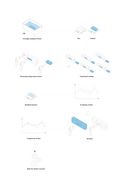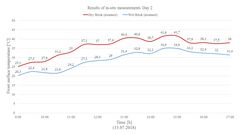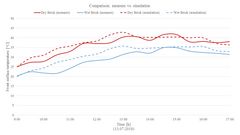Building envelopes and their materials have a major impact on the microclimate of our cities. The overheating of urban areas, the so-called "urban heat island" effect is a major problem in many countries, which will become more relevant in the context of climate change and densification of existing cities. Studies show that brick facades with low reflectivity can reduce the extreme heat load on pedestrians by 26 % during the day compared to heavily insulated casings (Ata Chokhachian, Perini, Dong & Auer, 2017).
Another study examines the effects of a watered brick wall, and the results show that the surface temperature of the wall is 5° C lower than the ambient temperature over the time of day (He & Liu, 2012). Therefore, in the future, architects will increasingly have to pay attention to the heat storage capacity of the materials and their thermally reflecting properties in their choice of materials for building envelopes.
Over the history of human settlements, approximately 30 % of the world’s population lived in brick made structures by 1990. It is also projected that the brick product segments will raise 3.5 % during 2017 to 2027 and it is anticipated to dominate over the forecast period. So far, energy regulations have pushed the innovation of bricks towards better U-values especially in northern and central Europe however there has been less attention to see brick as a climate active material able to improve microclimate conditions.
Within this regard this research is investigating the potentials of irrigated solid bricks as a component for climate adaptive facades able to enhance urban microclimate in urban canyons. The study shaped in two layers including field measurements and simulations. An experiment setup of façade panel is demonstrated to test different irrigation scenarios under varying environmental conditions and hours of the day to quantify surface temperatures and intensity of evaporative cooling effect. The results are validated with transient hygro-thermal simulation models in WUFI. The results show that in average wet bricks can have 7° C lower surface temperatures compared to dry ones. Also the color of the bricks is influencing the temperature curve where the difference of 5.4° C recorded between light and dark colored ones.
See the conference paper Adaptive Bricks: Potentials of Evaporative Cooling In Brick Building Envelopes to Enhance Urban Microclimate: https://books.bk.tudelft.nl/index.php/press/catalog/book/isbn_9789463661256



